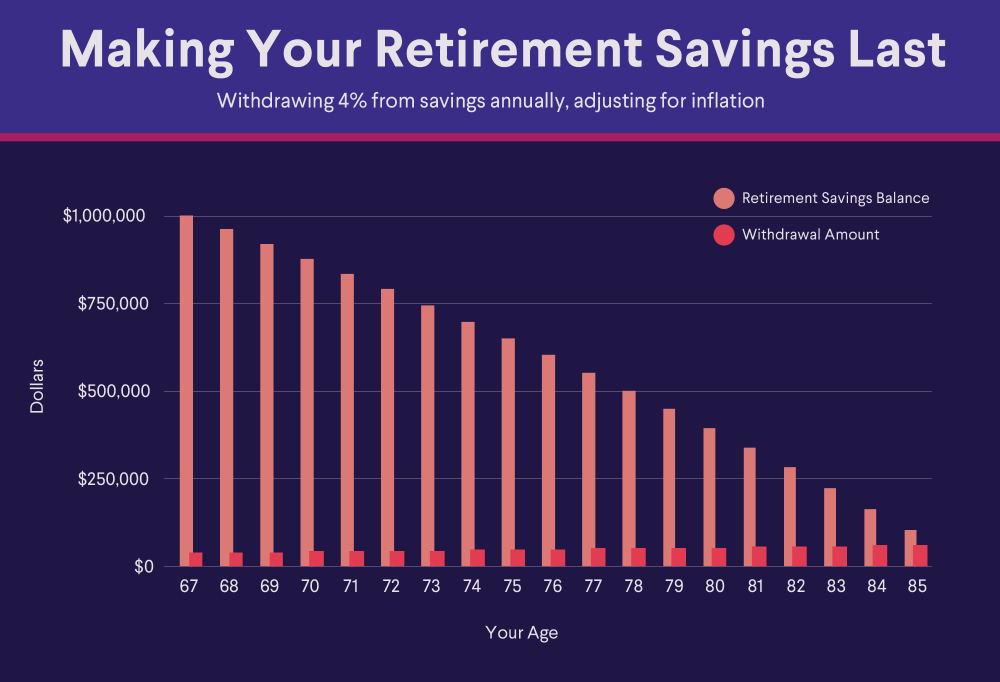4% Rule for Withdrawals in Retirement
After decades of saving for retirement, many new retirees often find themselves facing a new challenge: Determining how much money they can take out of their retirement account each year without running the risk of depleting their nest egg too quickly.
One popular rule of thumb is “the 4% rule.” What is the 4% rule? Learn more about the rule and how it works.
What Is the 4% Rule for Retirement Withdrawals?
The 4% rule suggests that retirees withdraw 4% from their retirement savings the year they retire, and adjust that dollar amount each year going forward for inflation. Based on historical data, the idea is that the 4% rule should allow retirees to cover their expenses for 30 years.
The rule is intended to give retirees some planning guidance about retirement withdrawals. The 4% rule may also help provide them with a sense of how much money they need for retirement.
💡 Quick Tip: How do you decide if a certain trading platform or app is right for you? Ideally, the investment platform you choose offers the features that you need for your investment goals or strategy, e.g., an easy-to-use interface, data analysis, educational tools.
How to Calculate the 4% Rule
To calculate the 4% rule, add up all of your retirement investments and savings and then withdraw 4% of the total in your first year of retirement. Each year after that, you increase or decrease the amount, based on inflation.
For example, if you have $1 million in retirement savings, you would withdraw 4% of that, or $40,000, in your first year of retirement. If inflation rises 3% the next year, you would increase the amount you withdraw by 3% to $41,200.
Drawbacks of the 4% Rule
While the 4% rule is simple to understand and calculate, it’s also a rigid plan that doesn’t fit every investor’s individual situation. Here are some of the disadvantages of the 4% rule to consider.
It doesn’t allow for flexibility
The 4% rule assumes you will spend the same amount in each year of retirement. It doesn’t make allowances for lifestyle changes or retirement expenses that may be higher or lower from year to year, such as medical bills.
The 4% rule assumes that your retirement will be 30 years
In reality an individual’s retirement may be shorter or longer than 30 years, depending on what age they retire, their health, and so on. If someone’s life expectancy goes beyond 30 years post-retirement they could find themselves running out of money.
It’s based on a specific portfolio composition
The 4% rule applies to a portfolio of 50% stocks and 50% bonds. Portfolios with different investments of varying percentages would likely have different results, depending on that portfolio’s risk level.
It assumes that your retirement savings will last for 30 years
Again, depending on the assets in your portfolio, and how aggressive or conservative your investments have been, your portfolio may not last a full 30 years. Or it could last longer than 30 years. The 4% rule doesn’t adjust for this.
4% may be too conservative
Some financial professionals believe that the 4% rule is too conservative, as long as the U.S. doesn’t experience a significant economic depression. Because of that, retirees may be too frugal with their retirement funds and not necessarily live life as fully as they could.
Others say the rule doesn’t take into account any other sources of income retirees may have, such as Social Security, company pensions, or an inheritance.
How Can I Tailor the 4% Rule to Fit My Needs?
You don’t have to strictly follow the 4% rule. Instead you might choose to use it as as a starting point and then customize your savings from there based on:
• When you plan to retire: At what age do you expect to stop working and enter retirement? That information will give you an idea about how many years worth of savings you might need. For instance, if you plan to retire early, you may very well need more than 30 years’ worth of retirement savings.
• The amount you have saved for retirement: How much money you have in your retirement plans will help you determine how much you can withdraw to live on each year and how long those savings might last. Also be sure to factor in your Social Security benefits and any pensions you might have.
• The kinds of investments you have: Do you have a mix of stocks, bonds, mutual funds, and cash, for instance? The assets you have, how aggressive or conservative they are, and how they are allocated plays an important role in the balance of your portfolio. An investor might want assets that have a higher potential for growth but also a higher risk factor when they are younger, and then switch to a more conservative investment strategy as they get closer to retirement.
• How much you think you’ll spend each year in retirement: To figure out what your expenses might be each year that you’re retired, factor in such costs as your mortgage or rent, healthcare expenses, transportation (including gas and car maintenance), travel, entertainment, and food. Add everything up to see how much you may need from your retirement savings. That will give you a sense if 4% is too much or not enough, and you can adjust accordingly.
Should You Use the 4% Rule?
The 4% rule can be used as a starting point to determine how much money you might need for retirement. But consider this: You may have certain goals for retirement. You might want to travel. You may want to work part-time. Maybe you want to move into a smaller or bigger house. What matters most is that you plan for the retirement you want to experience.
Given those variations, the 4% rule may make more sense as a guideline than as a hard-and-fast rule.
Recommended: How Much Retirement Money Should I Have at 40?
The Takeaway
The 4% rule represents a percentage that retirees can withdraw from their savings annually and theoretically have their savings last a minimum of 30 years. For example, someone following this rule could withdraw $20,000 a year from a $500,000 retirement account balance.
However, the 4% rule has limitations. It’s a rigid strategy that doesn’t take factors like lifestyle changes into consideration. It assumes that your retirement will last 30 years, and it’s based on a specific portfolio allocation. A more flexible plan may be better suited to your needs.
Having flexibility in planning for withdrawals in retirement means saving as much as possible first. A starting place for many people is their workplace 401(k), but that’s not the only way you can save for retirement. For instance, those who don’t have access to a workplace retirement account might want to open an IRA or a retirement savings plan for the self-employed to invest for their future.
Ready to invest in your goals? It’s easy to get started when you open an investment account with SoFi Invest. You can invest in stocks, exchange-traded funds (ETFs), mutual funds, alternative funds, and more. SoFi doesn’t charge commissions, but other fees apply (full fee disclosure here).
FAQ
How long will money last using the 4% rule?
The intention of the 4% rule is to make retirement savings last for approximately 30 years. How long your money may last will depend on your specific financial and lifestyle situation.
Does the 4% rule work for early retirement?
The 4% rule is based on a retirement age of 65. If you retire early, you may have more years to spend in retirement and your financial needs will likely be different.
Does the 4% rule preserve capital?
With the 4% rule, the idea is to withdraw 4% of your total funds and allow the remaining money in the account to keep growing. Because the withdrawals would at least partly consist of dividends and interest on savings, the amount withdrawn each year would not come totally out of the principal balance.
Is the 4% Rule Too Conservative?
Some financial professionals say the 4% rule is too conservative, and that retirees may be too frugal with their retirement funds and not live as comfortable a life as they could. Others say withdrawing 4% of retirement funds could be too much because the rule doesn’t take into account any other sources of income retirees may have.
Third-Party Brand Mentions: No brands, products, or companies mentioned are affiliated with SoFi, nor do they endorse or sponsor this article. Third-party trademarks referenced herein are property of their respective owners.
INVESTMENTS ARE NOT FDIC INSURED • ARE NOT BANK GUARANTEED • MAY LOSE VALUE
Financial Tips & Strategies: The tips provided on this website are of a general nature and do not take into account your specific objectives, financial situation, and needs. You should always consider their appropriateness given your own circumstances.
SoFi Invest®
1) Automated Investing and advisory services are provided by SoFi Wealth LLC, an SEC-registered investment adviser (“SoFi Wealth“). Brokerage services are provided to SoFi Wealth LLC by SoFi Securities LLC.
2) Active Investing and brokerage services are provided by SoFi Securities LLC, Member FINRA (www.finra.org)/SIPC(www.sipc.org). Clearing and custody of all securities are provided by APEX Clearing Corporation.
For additional disclosures related to the SoFi Invest platforms described above please visit SoFi.com/legal.
Neither the Investment Advisor Representatives of SoFi Wealth, nor the Registered Representatives of SoFi Securities are compensated for the sale of any product or service sold through any SoFi Invest platform.
SOIN0124010











